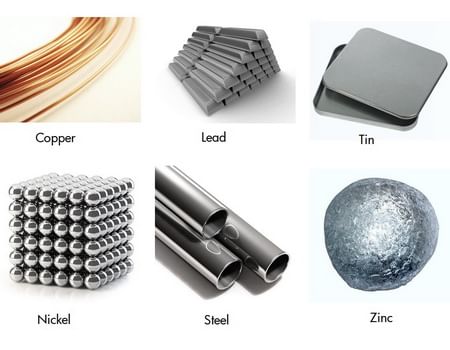Very Short Answers - Materials: Metals and Non-Metals, Science, Class 8 | Science for Grade 6 PDF Download
VERY SHORT ANSWER TYPE QUESTIONS
Q. 1. How many types of materials are there?
Ans. There are two types of materials:
(i) Metals (ii) Non-metals
Q. 2. You are given following materials. Classify them into metals and non‑metals Iron, Coal, Sulphur, Aluminium and Copper.
Ans. Iron, aluminium and copper are the metals. Coal, sulphur are non-metals.
 Metals Q. 3. How can you distinguish metals from non‑metals?
Metals Q. 3. How can you distinguish metals from non‑metals?
Ans. Metals can be distinguished from non-metals on the basis of their physical and chemical properties.
Q. 4. Name two physical properties.
Ans. (i) Lustre (ii) Hardness.
Q. 5. What do you mean by malleability?
Ans. The property of metals by which they can be beaten into thin sheets is called malleability.
Q. 6. Coal and pencil lead do not show the property of malleability. Can we call them metal?
Ans. No, they are not metals.
Q. 7. What do you mean by conductivity?
Ans. The metals allow the electricity to pass through them. This property of metals is called conductivity.
Q. 8. What is ductility?
Ans. The property of metals by which they can be drawn into wires is called ductility.
Q. 9. What do you mean by sonority?
Ans. The property of metal, to produce ringing sound is called sonority.
Q . 10. Why are metals called sonorous?
Ans. Since metals produce ringing sounds, they are called sonorous.
Q . 11. Which materials are called non‑metals?
Ans. The materials which are not sonorous and are poor conductor of heat and electricity are called non-metals.
Q . 12. Name two metals which can be cut with a knife.
Ans. Sodium and Potassium.
Q . 13. Write the name of a metal which is found in liquid state at room temperature.
Ans. Mercury.
Q . 14. What is rust chemically known?
Ans. The rust is chemically known as Iron III oxide.
Q . 15. What happens when a metal reacts with oxygen?
Ans. The metal oxide is formed when metal reacts with oxygen.
Metal + Oxygen → Metal oxide.
Q . 16. What is the nature of metal oxide?
Ans. The Metal oxides are basic in nature.
Q . 17. What happens when a solution of metal oxide is tested with (i) blue litmus and (ii) red litmus?
Ans. (i) No change in the colour of blue litmus.
(ii) The red litmus changes into blue colour.
Q . 18. Give a chemical equation when iron reacts with oxygen.
Ans. Iron (Fe) + Oxygen (O2) → Fe2O3 (iron oxide)
Q . 19. Name the product formed by the reaction of sulphur and oxygen.
Ans. Sulphur dioxide gas.
Q . 20. Write the balance chemical equation when sulphur dioxide is dissolved in water.
Ans. Sulphur dioxide (SO2) + Water (H2O) → Sulphurous acid (H2SO3)
Q . 21. What is the effect of sulphurous acid on blue litmus?
Ans. Blue litmus turns red.
Q . 22. What is the nature of non‑metal oxides?
Ans. Mostly non-metallic oxides are acidic in nature.
Q . 23. What happens when sodium reacts with water?
Ans. Sodium is highly reactive metal. It starts to burn in water to form sodium hydroxide.
Q . 24. Write a balanced chemical equation of the reaction that takes place between water and sodium.
Ans. 2Na + 2H2O → 2NaOH + H2
Q . 25. Why is sodium stored in kerosene?
Ans. Sodium reacts very vigorously with oxygen and water and catch fire. Therefore, it is stored in kerosene.
Q . 26. Name a non‑metal which is kept in water.
Ans. Phosphorous is stored in water.
Q . 27. What happens when a metal reacts with acids?
Ans. Metal generally reacts with acids to give hydrogen gas.
Q . 28. What happens when a non‑metal reacts with acid?
Ans. Non-metals do not react with acids.
Q . 29. Does metal also react with bases?
Ans. Metals also react with some bases like sodium hydroxide and produce hydrogen.
Q . 30. What do you mean by displacement reaction?
Ans. The reaction in which a more reactive metal can replace a less reactive metal but a less reactive metal cannot replace a more reactive metal is called displacement reaction.
Q. 31. Give one example of displacement reaction.
Ans. When copper sulphate solution reacts with zinc then it displaces copper.
CuSO4 (Copper sulphate) + Zn(Zinc) → ZnSO4 (Zinc sulphate) + Cu (Copper).
|
137 videos|271 docs|60 tests
|
FAQs on Very Short Answers - Materials: Metals and Non-Metals, Science, Class 8 - Science for Grade 6
| 1. What are metals and non-metals? |  |
| 2. Give examples of metals and non-metals. |  |
| 3. What are some properties of metals? |  |
| 4. What are some properties of non-metals? |  |
| 5. How are metals and non-metals used in everyday life? |  |

















